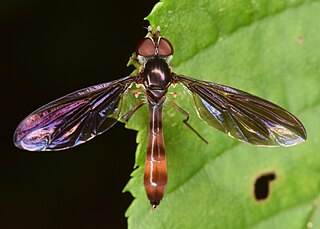
Eristalinus is a genus of hoverfly. Most species have very distinctive eye marking in the form of spots or banding, though these features may fade on some preserved specimens. Most are stout flies, and are nimble flyers, even compared to other hoverfly species.

Criorhina is a genus of hoverflies. Medium to large sized species, black or greenish black, with or without light ground markings mimicking bumblebees .The head is much flattened and broader than the thorax. The antennae are situated upon a prominent conical frontal process, The face is moderately produced below the eyes, downward or forward, in profile. The eyes are bare. The abdomen is elliptical or very short oval. Larvae found in rot holes or decaying hardwoods

Lejops is a genus of hoverflies, closely related to the genera Helophilus, Quichuana and Mallota.
Paragodon paragoides is a small (4–5 mm) hoverfly which differs from other hoverflies by its simple male genitalia, and was accordingly considered the most primitive microdontine species. It is the sole member of the genus Paragodon, as the other known species was removed to a separate genus, Surimyia.
Ubristes is a genus of hoverflies, with four known species. All are characterized by their metatibiae, which are usually enlarged, but always with a brush of long pile along the dorsal edges. These flies are probably mimics of the stingless bees in the tribe Meliponini.

The Syrphini are a tribe of hoverflies.

Ocyptamus is a large and diverse genus of over 200 species of hoverfly mostly found in the Neotropical region. It is likely that many of these species will be discovered to be synonyms though many others await description.

Hypocritanus fascipennis is a species of syrphid fly in the family Syrphidae. Until 2020, it was classified in the genus Ocyptamus.

Ocyptamus fuscipennis is a species of syrphid fly in the family Syrphidae.

Ocyptamus cubanus is a species of syrphid fly in the family Syrphidae.
Ocyptamus antiphates is a species of syrphid fly in the family Syrphidae.

Hypocritanus lemur is a species of syrphid fly in the family Syrphidae. Until 2020, it was classified in the genus Ocyptamus.
Pseudoscaeva is a genus of hoverfly in the Neotropical region, formerly included in the genus Ocyptamus, which was split after researchers determined it was not monophyletic.
Orphnabaccha is a genus of hoverfly in the Neotropical region, formerly included in the genus Ocyptamus, which was split after researchers determined it was not monophyletic.
Hybobathus is a genus of hoverfly in the Neotropical region, formerly included in the genus Ocyptamus, which was split after researchers determined it was not monophyletic.

Hypocritanus is a genus of hoverfly found in the Neotropical region.

Victoriana is a genus of hoverflies in the family Syrphidae. This genus, corresponding to the former Ocyptamus melanorrhinus species group, is currently divided into three species groups: V. attenuata, V. melanorrhina and V. parvicornis species groups.










